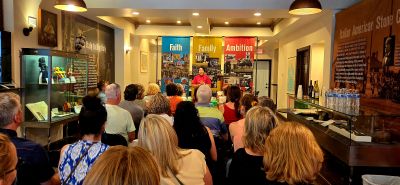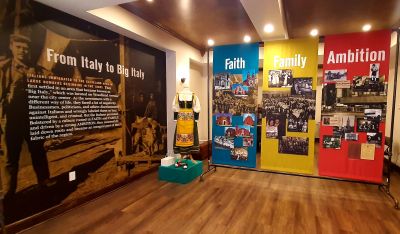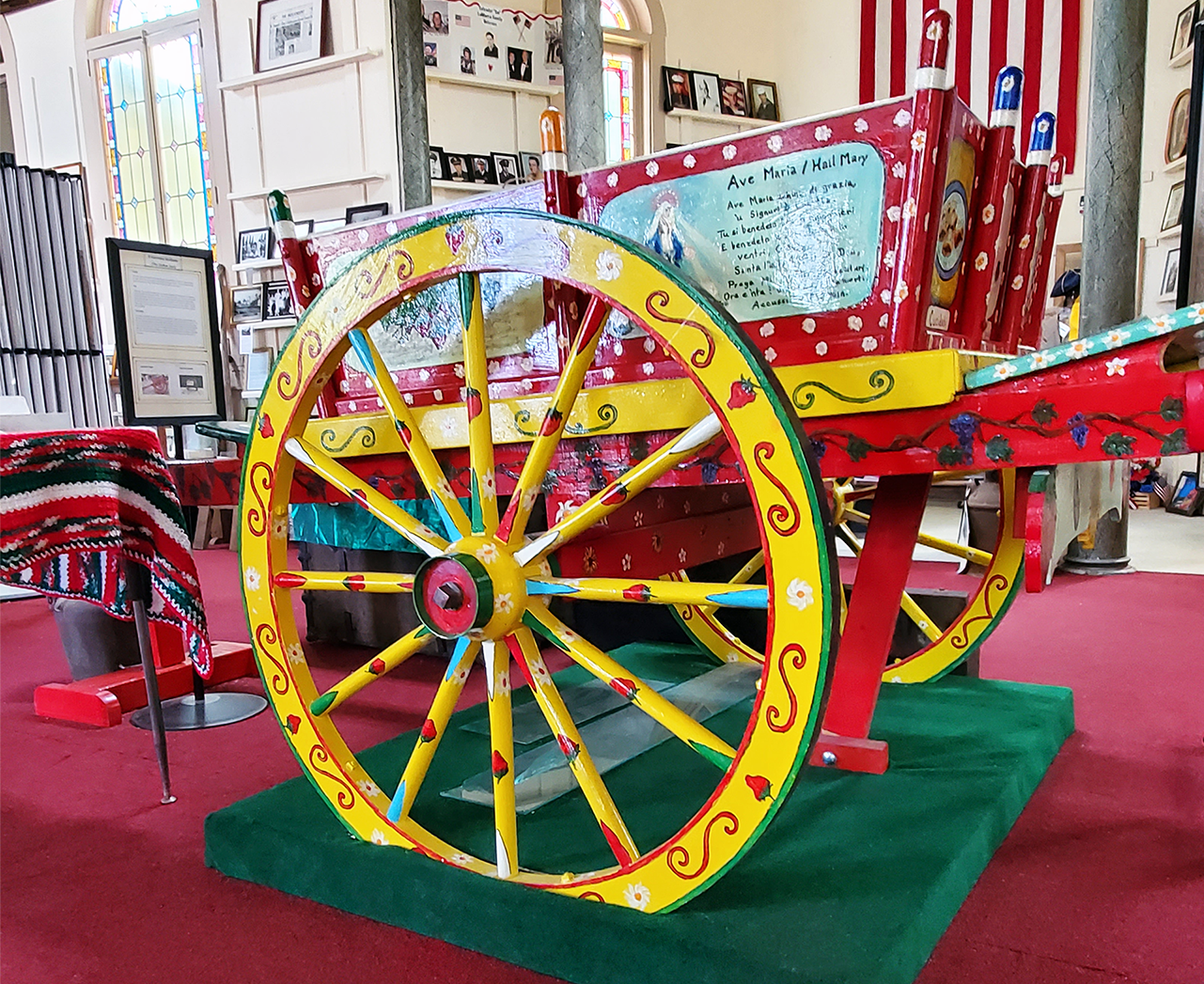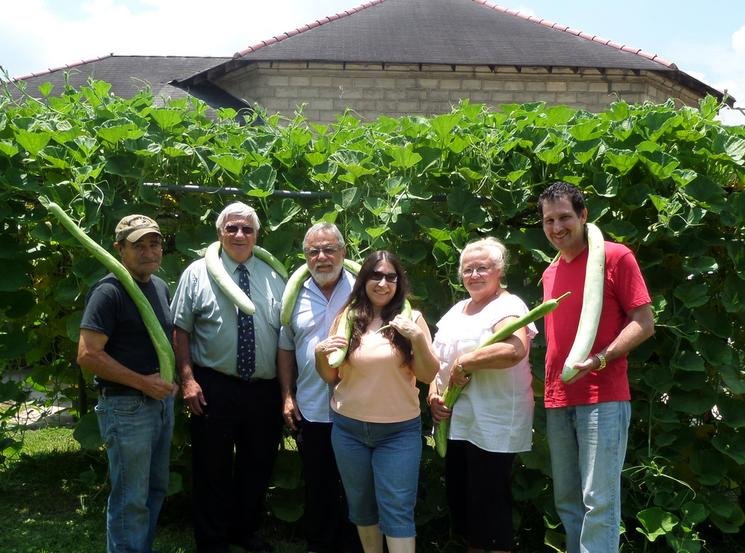An estimated 4 million Italians emigrated to the United States between 1880 and 1920, most seeking economic opportunities. About 25,000 of those people settled within seven neighborhoods of Cleveland. Many were scalpellini (stone carvers). Their hands and tools shaped many local buildings and structures, including the iconic Guardians of Traffic (the namesake of the city’s baseball team) on the Hope Memorial Bridge.
Setting stories of Cleveland’s Italian heritage in stone is mission-critical for the Italian American Museum of Cleveland (IAMCLE). Museum Director Pamela Dorazio Dean leads the charge, serving as both the Director and Curator of Italian American History at the Western Reserve Historical Society.
With a focus on "Faith, Family, and Ambition" in the Italian American experience, Pamela and her team showcase exhibits and offer events and educational programming, including Italian language and culture classes, as well as walking tours of Cleveland’s Little Italy, where the museum is located.
In addition to sharing the stories of Cleveland’s Italian immigrants and the IAMCLE’s founding, Pamela provided further details about the museum’s history, events, offerings, and goals.
What is the history of Italian immigration to Cleveland?
Cleveland has a pretty sizable Italian community. We're in the top 10 in terms of the number of people who still identify as having Italian heritage in Northeast Ohio.
They came mostly from Southern Italy (south of Rome) and Sicily. And for Cleveland, a lot of them came from the regions of Abruzzo and Molise, which used to be one region until the 1960s, when Molise broke off. So a lot of the older Italians still say they're from Abruzzo, but that's only because the regions used to be one. Many of them were stone carvers or sculptors—scalpellini, as they call them in Italian. And a lot of them were general laborers looking for work because none was available in Italy. They could not improve their station in life. It was a hopeless situation. So, they left Italy and came to the United States.
Some of them made money in the U.S. and then returned to Italy or sent money home, but the large majority stayed. In Cleveland, they initially settled in a neighborhood known as Big Italy. It was where the city center was, where the market district was located, where all the produce came through. It had been a Jewish community before the Italians moved in.
As the Italians were coming in the 1880s, they found inexpensive housing near places where they could find work, and the Big Italy neighborhood provided those things. It wasn’t until around 1885 that the Little Italy community started to form.
The area where Little Italy is now located was owned by the Cozad family, whose house is still standing just on the outskirts of Little Italy. They used the land for fruit orchards. They began selling off the land in the mid-1880s, and people began settling there. It became known as the East End of Cleveland. Then, when the Italians started coming in the late 1880s, it became known as the East End Italian Settlement. Eventually, it became known as Little Italy.

Cleveland's Little Italy
Tell us the story of the Italian Museum of Cleveland’s founding and its role in the Italian community.
The first museum in Little Italy was founded by a group of volunteers who lived in the neighborhood. They ran it from 1985 to 2007. It was all-volunteer, people concerned about preserving the history of the neighborhood, especially at a time when it was changing. A lot of the original Italian families had moved away. University Hospital and Case Western Reserve University are nearby and were buying up properties in the neighborhood.
This museum was a way to keep the museum and the neighborhood grounded in the past. It provided a home for many of the families that used to live in the neighborhood. When they would return to the neighborhood, they could go there and see various photos of the neighborhood’s past, First Communion class photos, old buildings, and old friends.
The two ladies who were running that museum, Lauretta Nardolillo and Eva Maesta, whom I met in 2007, were in their early eighties and said they needed to step away from the museum. No one wanted to pick up where they had left off. So, they donated all of the museum’s collection to the Western Reserve Historical Society, where I worked and am still working as a curator of Italian American history.
I cataloged and organized all of the materials. When that museum closed, I realized there was a hole left in the neighborhood. People know it's a historic neighborhood, and they know it's an Italian neighborhood. But there was really nowhere for them to explore and understand what the neighborhood was about, who the people were who made it, and all the contributions they made to not only that neighborhood but to Northeast Ohio.
I had been talking about it within the Italian community for a while, and I finally got funding from the Italian Sons and Daughters of America. Basil Russo, who lives here in Cleveland, is the national president of that organization. He agreed with me and thought my vision for a museum was exactly what the neighborhood needed, what the Italian-American community needed, and what the city of Cleveland needed to understand our contributions.
Often, in our community, people fall back on the mafia stories. And while that is a part of our culture and part of who we are, it's a very small percentage; less than 1% were involved in the mafia, but it gets 110% of the attention. So we wanted to emphasize the more positive aspects. The museum received funding in 2020. We didn't open right away because of the pandemic, so we ended up having our grand opening in October of 2021.

The Italian American Museum of Cleveland focuses on "Faith, Family, and Ambition."
What kind of exhibits can visitors expect to see at IAMCLE?
We're very small. We only have about 900 square feet of exhibit space. It's basically one long rectangle in an old building built in 1902 in the Little Italy neighborhood. It was a bank, and then it was home to Presti's Bakery, which is still very popular in the neighborhood.
Right now, we have an overview of Italians in Cleveland. It's called “Faith, Family, and Ambition,” and it defines the values of Italian culture that helped the immigrants be successful and settle in the United States, specifically in Cleveland. We have photographs and some objects on display.
We tell the story of the stone carvers, which is very important not only for settling the Little Italy neighborhood but because the Guardians of Traffic, who our baseball team is now named for, were carved in Little Italy by immigrant stone carvers from a town called Oratino, Italy, which is in the Molise region. A lot of people are unaware of that and that's a great story., People are more interested in learning the history of those statues because our baseball team changed its name to the Guardians.
Next month, we will be opening a national traveling exhibit on Louis Prima, the Sicilian singer who was born and raised in New Orleans and became very popular in the 1940s and 1950s. He was just an amazing musician, but quite a character. He helped popularize not only jazz in general, but also Italian music, because he often sang in Italian. That exhibit started in New Orleans. It was also at the Italian American Museum of Los Angeles and the American Jazz Museum in Kansas City. It will come to Cleveland and be here through the end of the year.

IAMCLE visitors trace Cleveland's Italian American history from emigration to Big Italy and Little Italy.
What events and programming does the museum offer?
We want the museum to be a community gathering space instead of just a place where people come and look at exhibits. We want to bring the community together and teach them about Italian and Italian American culture.
One of our popular offerings is our Italian language classes. We partner with Dr. Paola Basile, who is a professor and head of the Italian Studies Program at Lake Erie College in Painesville, Ohio, and a native of Rome, Italy. She is an excellent teacher, and those classes always fill up. People are very interested in learning the Italian language.
We also offer classes where we explore the different regions of Italy, again taught by Dr. Basile. There are 20 distinct regions in Italy, each with its own traditions, foods, and interesting UNESCO sites. Dr. Basile reviews all of the interesting information about the region. Then, at the end of class, we taste food and wine from the region, which is very popular. People love having some wine and a little taste of Italy after class.
Another of our offerings is walking tours of the Little Italy neighborhood in the summer months, in partnership with an organization called Take a Hike. They offer historic tours throughout the city of Cleveland.
What's really cool about the Take a Hike tours is that they have actors playing characters from the neighborhood during the tour. For this year’s tour, we will have stone carver Domenicantonio Mastrangelo, who helped carve the Guardians of Traffic, and Rocky Colavito, an Italian-American baseball player who played for the Cleveland Indians in the 1950s. It’s going to be a really fun tour.
We offer other events that pop up along the way. Sometimes, authors will contact me, somebody who has written a book about Italy or their Italian family history, and we'll have author talks, meet-and-greets, and those kinds of things.
What do you ultimately hope to share?
I hope the museum will help people understand that our culture is more than food and the mafia. We've made significant contributions, as shown here in the city of Cleveland and the region of Northeast Ohio. I especially want people to learn about the impact that the stone carvers made in our city and region. That's one story that has kind of gotten lost in history.
Little Italy is adjacent to Lake View Cemetery, a beautiful park-like cemetery founded in the 1870s. Many of the monuments and headstones there were carved by Italian and Italian American stone carvers.
Italians have also contributed to buildings in downtown Cleveland. So, there's the artistic aspect of the Italian immigrants that a lot of people don't think about immediately. They think about the greats like Michelangelo, but these ordinary Italians also had many artistic skills that they learned while they were in Italy and brought over with them.
Italians have been influential in business and politics, the arts, and the construction industry. We want to bring that story of who we are and how Italians helped make Northeast Ohio a great region through our contributions to the forefront, and we do that at IAMCLE.
If you enjoyed this article, consider subscribing to my newsletter for more content and updates!






